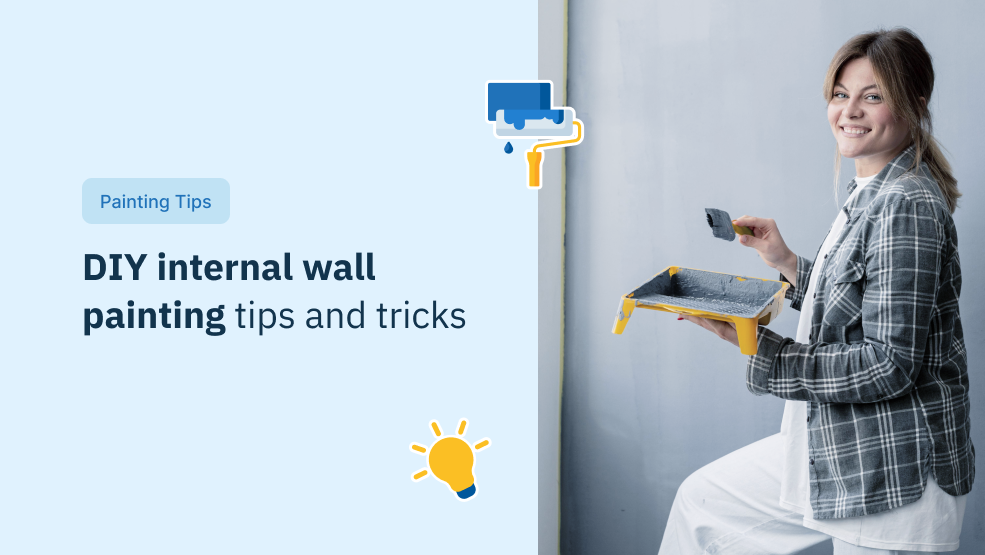Are you planning to revamp your living space with a fresh coat of paint? Whether you’re sprucing up a room or embarking on a full-blown makeover, mastering the art of painting is essential for achieving stunning results. This comprehensive guide is packed with insider tips and tricks, from prep work and tool selection to perfecting your technique and maintaining your walls for years to come. With the right approach and a splash of creativity, you can transform your home into a masterpiece that reflects your unique style. Let’s get painting!
Spring and fall is the best time to paint
When you’re painting, it’s important to consider the temperature and humidity. The first painting tip is to find out the best time to start the project. The best time to paint is when the humidity is low and the temperature is between 60-85°F. High humidity can make the paint dry slowly and cause problems like blistering. Extreme heat can also be uncomfortable and affect the paint’s quality. In winter, cold temperatures can make the paint thick and hard to apply, and it’s tricky to ventilate the area well.
That’s why it’s a good idea to avoid painting in the peak summer and winter months. Instead, spring and fall are great times for indoor painting. The temperatures are usually just right, and the humidity levels are lower, which helps the paint dry properly. These seasons give you a comfortable environment for painting and allow for good ventilation, making the job easier and ensuring a better result.
Preparation is key
Start your DIY interior painting project with thorough preparation to ensure a flawless finish. Here is a structured approach to get your walls ready.
Preparing your walls for painting is crucial for a flawless finish. Start by repairing any damages using a lightweight spackling compound for small holes and a drywall patch with joint compound for larger areas. After sanding these spots smooth, clean the walls thoroughly to remove dust, grime, and mildew, using a sugar soap solution for stubborn stains or grease. Sand the entire wall with 100-grit sandpaper to eliminate old paint and imperfections, then use a drywall pole sander with 200-250-grit paper for a final smooth finish.
Next, mask off areas with painter’s tape along baseboards, window, and door trims, ensuring the tape reaches the wall’s edge for clean paint lines. Protect floors with canvas drop cloths and cover or move furniture. Unscrew and cover outlet and switch plates with tape to prevent paint splatters.
For priming, choose the right type based on your surface: a general-purpose water-based latex primer for walls, oil-based for bare wood trim, and a bonding primer for surfaces previously painted with oil-based paint. Applying primer is especially crucial for bare drywall, stained areas, or when making drastic color changes; consider using a paint-and-primer-in-one product to save time.
By adhering to these steps, you’re setting the stage for a successful interior painting project. Remember, the quality of your preparation directly influences the outcome of your painting efforts.
Mastering the brush and roller
The next painting tip is to master the use of brush and roller. To begin, attach a 48-inch wood handle to your roller frame for better control and extended reach, enhancing your ability to cover large areas efficiently. Opt for a 5-gallon bucket with a bucket screen rather than a traditional paint tray for smoother and more efficient paint application. When selecting roller covers, choose high-quality 1/2-inch nap wool blend covers to achieve superior results. To minimize shedding, wrap the roller cover with masking tape before use. When loading the roller, dip it about 1/2 inch into the paint and then roll it against the screen to evenly distribute the paint, ensuring consistent coverage on the wall.
When it comes to brush techniques, use a 2-inch angled brush for precision work along edges and corners, allowing you to achieve clean lines and detailed finishes. Synthetic brushes are ideal for water-based paints, while natural brushes work best with oil-based paints, ensuring optimal performance and longevity of the brush. For textured surfaces, opt for thicker roller covers to effectively cover the uneven surface, while thinner covers are more suitable for smooth surfaces, ensuring a smooth and even finish.
To apply paint effectively, start painting about 6 inches away from the edge to prevent paint buildup, gradually working your way towards the edge for a seamless finish. Apply paint quickly and spread it out evenly to avoid lap marks, ensuring a uniform appearance across the entire surface. To maintain color consistency, mix several cans of paint before starting the project. Additionally, dampen the roller cover with a wet rag before use to improve paint application, allowing the paint to spread more smoothly and evenly. By employing these techniques, you will enhance your painting skills and achieve professional-grade results in your interior painting projects.
Achieving the perfect finish
For a flawless finish in your interior painting project, precision, patience, and the right techniques are key. Begin by ensuring smooth application: keep a wet rag handy to quickly address any lumps that may appear on the wall, and strain used paint through a mesh paint strainer to eliminate any remaining lumps. When applying paint, use a ‘W’ or ‘M’ pattern for even distribution and to avoid roller marks. Maintain a wet edge by overlapping each stroke before the paint dries to prevent streaks. For optimal coverage, apply three coats of paint, allowing adequate drying time between coats.
In detailing and perfection, start with the trim, then the ceiling, and finally the walls, to simplify taping and ensure clean lines. Inspect for imperfections and touch-up as needed while the paint is still wet, ensuring a smooth and professional-looking finish. Use a sharp utility knife to cut the tape loose once the paint is dry, ensuring a clean edge.
In preparation and order, clean dirty surfaces thoroughly before starting to ensure the paint adheres properly. Calculate paint quantity accurately to avoid running out or overbuying; typically, one gallon covers 400 square feet. When painting, start from the top down: ceiling first, then walls, and trim last, to manage drips and ensure a seamless finish. By following these steps, you’ll achieve a perfect finish that will make your home look refreshed and revitalized. Remember, meticulous preparation, careful application, and attention to detail are key to a successful interior painting project.
Cleanup and maintenance
After dedicating time and effort to your interior painting project, ensuring proper cleanup and maintenance is crucial for preserving your work and keeping your tools ready for future projects. Begin by caring for your brushes and rollers: immediately rinse them after use, using warm soapy water for water-based paints and mineral spirits or paint thinner for oil-based paints. After cleaning, spin out excess moisture and hang brushes to dry, maintaining their shape. Remove roller covers from the frame, clean them thoroughly, and store them properly to prevent damage.
For paint and equipment maintenance, wipe the rims of paint cans clean before sealing them with a pour-in lid to ensure the paint remains usable for future touch-ups. Keep your skim coating tools clean and organized, sealing joint compound properly to prevent it from drying out. When it comes to wall maintenance, regularly dust the painted surfaces with a microfiber
For cleaning, use a mild detergent with water, testing on a small area first to ensure compatibility with the paint finish. Address specific stains like grease or crayon with appropriate cleaners, again testing a small area first to avoid damaging the paint. By following these maintenance tips, your home’s interior paint will stay vibrant, and your tools will remain in prime condition for your next home improvement project.
Why DIY painting might not be your best bet
When you’re thinking about painting your home yourself, it can seem like a great way to save money and feel accomplished. However, there are times when hiring a professional painter is a smarter choice. Professional painters bring a wealth of experience and skill to the job. They understand the nuances of different paint types and surfaces, ensuring that your project is done correctly the first time. This includes important steps like proper preparation, such as sanding, priming, and patching, which can be overlooked by amateurs.
Professional painters are efficient, completing jobs in less time than it would take to do it yourself. This means quicker turnaround times, with less disruption to your daily life. Safety is also a critical factor to consider. Painting can involve working at heights, handling potentially hazardous materials, and using specialized equipment. While DIY painting can be rewarding, it is important to recognize when a project may be beyond your skill level or safety comfort zone. For dangerous projects, such as those involving heights or specialized equipment, hiring a professional is often the safest and most effective choice.
Professional painters prioritize safety, using the right gear, and following proper guidelines to prevent accidents. They also have the expertise to identify and address underlying issues like water damage or mold, ensuring a high-quality finish. Professionals have access to high-quality paints and supplies that may not be readily available to consumers. These products offer superior durability, coverage, and application ease, resulting in a longer-lasting paint job.
Additionally, reputable painting companies are insured, providing you with peace of mind knowing that you are protected from liability in case of accidents or damage. While hiring professional painters may involve an upfront cost, it can be a wise investment in the long run. They can save you time, ensure a high-quality finish, and provide you with peace of mind knowing that the job is done right.
Inquire if they use FSM software
So, you’ve decided to hire a professional painter to spruce up your home. Now, the challenge is finding the right one. Price, reputation, and quality matter, but there’s another factor you might overlook—technology. Look for painters who use technology. Things like project management tools, customer management systems, and a customer portal are all good signs. But the best is the use of Field Service Management (FSM) software.
Think about a platform like Zuper—it’s a central hub for all things painting. It combines customer management, business tools, accounting, expense tracking, and payment processing—all working together with other apps you might use. Automated workflows, a customer portal, and real-time arrival notifications ensure a smooth experience.
By choosing a painter that uses FSM software, you’ll get organized, efficient service and stay informed every step of the way. Say goodbye to stress and welcome the future of home improvement!
Choosing the right painting service: What to ask before you decide
Before you decide on a painting service, take some time to look into what they offer. Here’s what you should ask:
Services offered: Find out if they specialize in interior or exterior painting or both. Do you have a unique project that needs special finishes or furniture painting? Make sure they can handle your specific needs.
Preparation and cleanup: A good paint job starts with careful preparation. Ask about their pre-painting routine, like cleaning surfaces, fixing any flaws, and applying primer. Also, ask about their cleanup process – will they leave your space clean?
Timeline and project management: Talk about how long the project will take. How will they keep you updated? Regular communication is important – will they give you updates on progress and answer your questions?
Cost and estimates: Get written estimates from a few companies. These should detail the work to be done, including which areas will be painted. Ask if the costs of materials (paint, primer, etc.) and labor are included. Also, ask for a breakdown of the costs for each part of the job, and make sure any extra fees are clear. Compare estimates from different companies. Price is important, but also consider their experience, services, and warranty details.
By looking into these details, you can choose a painting service that does quality work, manages projects well, and communicates clearly – all at a fair price. This will make your home improvement project smooth and stress-free.
DIY or professional help?
Painting your home’s interior can be a rewarding DIY project, but it requires careful planning, preparation, and technique to achieve professional results. There are times when hiring a professional painter might be a better choice, especially for complex projects or when you lack the time, skills, or tools to do the job effectively. Whether you choose to DIY or hire a professional, the key takeaway is to invest time and effort into the preparation and execution of your painting project. With the right approach, you can achieve a stunning result that enhances your home’s beauty and reflects your unique style.
Step up and be a force for good. For every T-shirt you wear, over 700 gallons of water is consumed. You hold the power to reclaim gallons of water with every garment you wear. Choose minimalism; Save water. Mindful closet for a sustainable future!
















